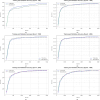Fusion of transfer learning with nature-inspired dandelion algorithm for autism spectrum disorder detection and classification using facial features
- PMID: 39730903
- PMCID: PMC11680803
- DOI: 10.1038/s41598-024-82299-6
Fusion of transfer learning with nature-inspired dandelion algorithm for autism spectrum disorder detection and classification using facial features
Abstract
Autism spectrum disorder (ASD) is a neurologic disorder considered to cause discrepancies in physical activities, social skills, and cognition. There is no specific medicine for treating this disorder; early intervention is critical to improving brain function. Additionally, the lack of a clinical test for detecting ASD makes diagnosis challenging. To regulate identification, physicians entertain the children's activities and growing histories. The human face is employed as a biological signature as it has the potential reflections of the brain. It is utilized as a simpler and more helpful tool for early detection. Artificial intelligence (AI) algorithms in medicinal rehabilitation and diagnosis can help specialists identify various illnesses more successfully. However, owing to its particular heterogeneous symptoms and complex nature, diagnosis of ASD remains to be challenging for investigators. This work presents a Fusion of Transfer Learning (TL) with the Dandelion Algorithm for Accurate Autism Spectrum Disorder Detection and Classification (FTLDA-AASDDC) method. The FTLDA-AASDDC technique detects and classifies autism and non-autism samples using facial images. To accomplish this, the FTLDA-AASDDC technique utilizes a bilateral filter (BF) approach for noise elimination. Next, the FTLDA-AASDDC technique employs a fusion-based TL process comprising three models, namely MobileNetV2, DenseNet201, and ResNet50. Moreover, the attention-based bi-directional long short-term memory (A-BiLSTM) method is used to classify and recognize ASD. Finally, the Dandelion Algorithm (DA) is employed to optimize the parameter tuning process, improving the efficacy of the A-BiLSTM technique. A wide range of simulation analyses is performed to highlight the ASD classification performance of the FTLDA-AASDDC technique. The experimental validation of the FTLDA-AASDDC technique portrayed a superior accuracy value of 97.50% over existing techniques.
Keywords: Autism spectrum disorder; Bilateral filter; Dandelion algorithm; Facial image; Fusion process; Transfer learning.
© 2024. The Author(s).
Conflict of interest statement
Declarations. Competing interests: The authors declare no competing interests.
Figures













Similar articles
-
Two-tier nature inspired optimization-driven ensemble of deep learning models for effective autism spectrum disorder diagnosis in disabled persons.Sci Rep. 2025 Mar 24;15(1):10059. doi: 10.1038/s41598-025-93802-y. Sci Rep. 2025. PMID: 40128287 Free PMC article.
-
HCBiLSTM-WOA: hybrid convolutional bidirectional long short-term memory with water optimization algorithm for autism spectrum disorder.Comput Methods Biomech Biomed Engin. 2025 May;28(6):818-840. doi: 10.1080/10255842.2024.2399016. Epub 2024 Sep 18. Comput Methods Biomech Biomed Engin. 2025. PMID: 39290085
-
Enhancing neurological disease diagnostics: fusion of deep transfer learning with optimization algorithm for acute brain stroke prediction using facial images.Sci Rep. 2025 Apr 10;15(1):12334. doi: 10.1038/s41598-025-97034-y. Sci Rep. 2025. PMID: 40210979 Free PMC article.
-
Machine learning in autistic spectrum disorder behavioral research: A review and ways forward.Inform Health Soc Care. 2019 Sep;44(3):278-297. doi: 10.1080/17538157.2017.1399132. Epub 2018 Feb 13. Inform Health Soc Care. 2019. PMID: 29436887 Review.
-
Do it the transformer way: A comprehensive review of brain and vision transformers for autism spectrum disorder diagnosis and classification.Comput Biol Med. 2023 Dec;167:107667. doi: 10.1016/j.compbiomed.2023.107667. Epub 2023 Nov 3. Comput Biol Med. 2023. PMID: 37939407 Review.
References
-
- Rahman, S., Ahmed, S. F., Shahid, O., Arrafi, M. A. & Ahad, M. A. R. Automated detection approaches to autism spectrum disorder based on human activity analysis: a review. Cogn. Comput., pp.1–28. (2021).
-
- Xia, C., Chen, K., Li, K. & Li, H. Identification of autism spectrum disorder via an eye-tracking based representation learning model. In 2020 7th International Conference on Bioinformatics Research and Applications (pp. 59–65). (2020).
-
- Ahmed, I. A. et al. Eye Tracking-based diagnosis and early detection of autism spectrum disorder using machine learning and deep learning techniques. Electronics, 11(4), p.530. (2022).
-
- Anden, R. & Linstead, E. December. Predicting eye movement and fixation patterns on scenic images using machine learning for children with autism spectrum disorder. In 2020 IEEE International Conference on Bioinformatics and Biomedicine (BIBM) (pp. 2563–2569). IEEE. (2020).
MeSH terms
LinkOut - more resources
Full Text Sources
Medical
Miscellaneous

